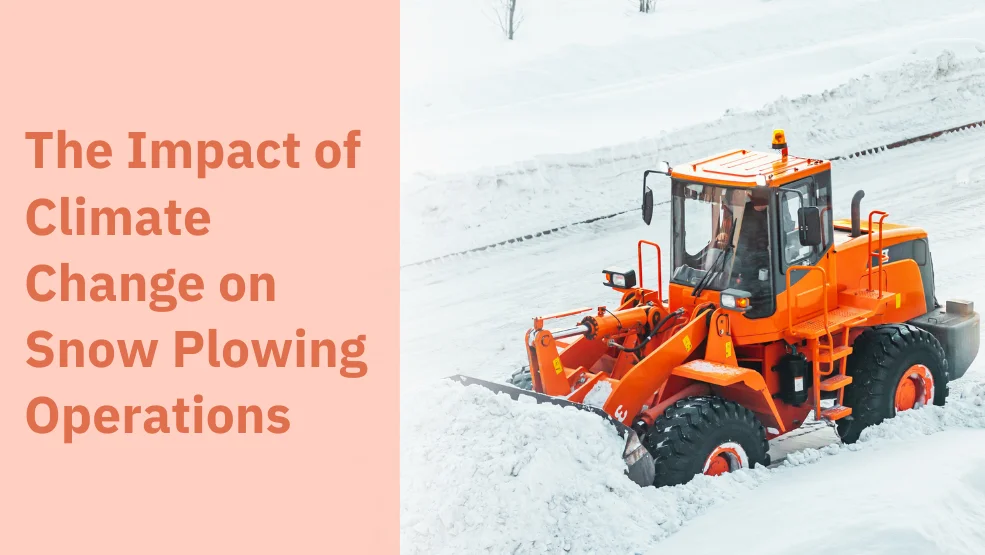Climate change has become a global phenomenon that has started affecting various aspects of every business—from launching to day-to-day operations. There has been a vast difference in the climate from extreme heat to unforeseen floods. But that doesn’t end there; the impact of these changes extends to affecting various industries, from agriculture to transportation and energy. One among them that has a significant impact is the snow removal business.
As years passed, the winter started becoming milder, and snowfall patterns shifted. Snow removal experiences unique challenges and tries to adapt to new realities. In this article, we will explore how climate change impacts the snow removal industry and the measures that can be taken so we don’t fall into this rabbit hole.
1. Decreased Snowfall and Shortened Winter Seasons
The effects of climate change on winter weather present a range of challenges. One significant impact is the decrease in snowfall across various regions, leading to a decline in overall snow volume. This is because continuously rising temperatures contribute to shorter winter seasons, causing earlier transitions to spring and delayed starts to winter. This, in turn, reduces the duration of snow cover, altering traditional winter patterns.
The consequences of these changes are particularly pronounced for snow removal businesses. Less snow reduces demand for services like clearing driveways, parking lots, and roofs, directly impacting their income. Furthermore, the unpredictable nature of snowfall creates challenges in terms of scheduling and staffing for these businesses, leading to inconsistent income.
2. Increased Variability and Intensity of Snowstorms
In some regions, the impact of climate change on winter weather is manifesting as a decrease in overall snowfall, contrary to concerns about increased snowfall. This seemingly paradoxical phenomenon is attributed to complex factors such as shifts in precipitation patterns and rising temperatures, leading to a higher incidence of rain rather than snow. Despite this reduction in snowfall, climate change is contributing to more unpredictable and intense snowstorms when they do occur.
For professionals in the snow removal industry, these changes pose significant challenges. The unpredictability of snowstorms complicates the planning process, as past patterns can no longer be relied upon to forecast snowfall and allocate resources effectively. Snow removal professionals must now enhance their flexibility and adaptability, swiftly adjusting schedules, deploying manpower and equipment efficiently, and responding to rapidly changing weather conditions.
3. Shifts in Equipment and Technology
The snow removal industry is constantly grappling with the challenges posed by nature. Adopting new technologies is a critical strategy for overcoming these obstacles and streamlining your operations, making them safer and more efficient. One notable aspect of these upgrades is the development of adaptable machinery designed to tackle a variety of conditions. Modern snow removal equipment features adjustable blades that can smoothly transition between plowing through thick snow and scraping icy surfaces. This multifunctionality eliminates the need for multiple machines, ultimately saving time and resources.
In addition to advancements in machinery, technology is harnessed more broadly to enhance the efficiency of snow removal operations. Real-time weather data analysis enables snow removal teams to anticipate the intensity and timing of snowfall, optimizing deployment and prioritizing critical areas. GPS trackers on trucks and equipment provide dispatchers with real-time monitoring of their location and progress, enhancing coordination and ensuring the efficient allocation of resources.
4. Focus on Sustainable Practices
Ensuring sustainable practices in snow removal is imperative for environmental protection, particularly in the context of growing concerns about climate change. Adopting an environmentally conscious approach involves considering various positive impacts and exploring potential challenges and opportunities within the industry. One positive impact of sustainable snow removal practices is reduced reliance on harsh chemicals.
Traditionally, snow removal has heavily depended on salt and other chemicals, which can contaminate soil and water sources and disrupt ecosystems. However, opting for gentler alternatives such as magnesium chloride or calcium chloride helps minimize these harmful effects. Furthermore, ongoing research and development in eco-friendly technologies, such as efficient snow-melting systems and alternative ice-control materials, can advance sustainable snow-removal practices.
5. Diversification of Services
The snow removal industry is changing radically as shorter winters and unpredictable snowfall patterns render the traditional “shovel and plow” model less dependable. In response to these challenges, innovative snow removal businesses are embracing diversification, extending their services beyond winter months to become year-round assets for their clients.
Leveraging their existing equipment and workforce, many businesses now offer landscaping services during warmer seasons, encompassing activities such as mowing, trimming, planting, and garden maintenance. The benefits of this service diversification are manifold. Beyond generating increased revenue by reducing dependence on snowfall, offering a broader array of services allows companies to attract and retain skilled employees who may otherwise seek seasonal work elsewhere. Diversification also strengthens relationships with existing clients, transforming these businesses into one-stop shops for all their seasonal needs and fostering loyalty and trust.
6. Collaboration and Industry Adaptation
Collaboration emerges as a key strategy in addressing all those unforeseen challenges. Snow removal professionals can share knowledge, experiences, and best practices through industry associations, conferences, and online forums, enabling them to learn from each other and adapt their strategies to the evolving conditions. This collective approach facilitates problem-solving and innovation, leading to the development of new technologies and techniques for tackling challenges related to climate change. For instance, sharing data on snowfall patterns and real-time conditions can optimize resource deployment and improve response times in the face of unpredictable weather events.
Conclusion
Climate change profoundly impacts the snow removal industry, presenting challenges such as decreased snowfall, unpredictable snowstorms, and shifts in traditional practices. However, the industry is responding with technological innovations, sustainable practices, and service diversification. Collaboration among professionals is crucial for sharing knowledge and adapting to the evolving conditions. In the face of climate change, the snow removal industry is not just adapting; it is transforming, becoming more resilient, and better equipped to navigate the challenges ahead.





